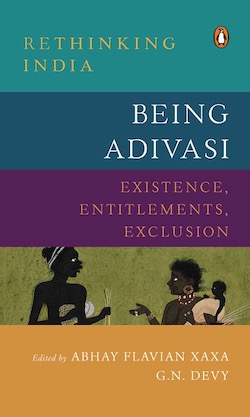Indigenous languages by GANESH N. DEVY | Full text >>
Excerpts from the modified version of the text of UNESCO lecture, October 2008RECOGNIZED as ‘Aborigines’ in Australia, as ‘Mâori’ in New Zealand, as ‘First Nations’ in Canada, as ‘Indigenous’ in the United States, as ‘Janajatis’ in India, or as ‘tribes’ in anthropology, as ‘Notified Communities’ in the administrative parlance of many countries, as ‘Indigenous People’ in the discourse of human rights, and as ‘Adivasis’ in the terminology of Asian activists, these variously described communities are far too numerous and dispersed in geographical locations to admit of any single inclusive description.
It would be simplistic to perceive them as divergent victim groups of any shared epochal phenomenon such as colonialism, imperialism, modernity or globalization. In their ethnic, cultural and linguistic attributes, they are so varied that it is almost impossible to speak of them as a common category of humanity. No single term can describe them with any degree of semantic assuredness. Even if one were to accept one or another term for the purpose, its normative frame may run up against numerous contradictions with the strikingly divergent history of every community. Though such descriptive sociological terms often perform a degree of communicational theatre, a scrutiny of the range of signification that the term is expected to cover reminds one that most discursive concepts are perennially contestable. […]
In India, Sir George Grierson’s Linguistic Survey of India (1903-1923) – material for which was collected in the last decade of the 19th century – had identified 179 languages and 544 dialects. The 1921 Census reports showed 188 languages and 49 dialects. The 1961 Census reports mentioned a total of 1,652 ‘mother tongues’, out of which 184 ‘mother tongues’ had more than 10,000 speakers, and of which 400 ‘mother tongues’ had not been mentioned in Grierson’s survey, while 527 were listed as ‘unclassified’. In addition, 103 ‘mother tongues’ were listed as ‘foreign’. In the 1951 Census, the ‘foreign’ languages found spoken in India were listed at 63, thus showing a ‘discovery’ of 50 new ‘foreign’ languages in a matter of a decade.
In 1971, the linguistic data offered in the census was distributed in two categories, the officially listed languages of the 8th Schedule of the Constitution, and the other languages with a minimum of 10,000 speakers each. All other languages spoken by less than 10,000 speakers were lumped together in a single entry ‘Others’. That practice continued to be followed in subsequent enumerations. Linguist Uday Narayan Singh comments:
‘The problem with Indian labels is that the 1961 Census had floated so many mother tongue labels especially among the unclassified languages that it will have to be worked out as to how many of them finally survived – which is itself a gigantic task. […]
The preservation of a language therefore, involves respecting the world view of the given speech-community. If such a community believes that human destiny is to belong to the earth, and not to offend the earth by claiming that it belongs to us, the language of that community cannot be preserved if one invites the community to share a political imagination that believes in vandalizing the earth’s resources in the name of development. In such a situation, the community will have only two options: it can either reject the Utopia that asserts the human right to exploit natural resources and turn them into exclusively commercial commodities, or it can reject its own world view and step out of the language system that binds it with the world view. […]
The creation of texts, dictionaries, glossaries and grammars in the declining languages will be of use; documentation, museumization and archiving too will be of some help; but if the languages are to survive, the speech communities need to be given the dignity and respect that they deserve, not as anthropological others, not as the last and underdeveloped traces of the self, but in their own right as deserving of respect because of who they are.
It takes centuries for a community to create a language. All languages created by human communities are our collective cultural heritage. Therefore, it is our collective responsibility to ensure that they do not face the global phonocide let loose in our time.
Footnotes:
- Shiv Visvanathan, ‘Listening to the Pterodactyl’, in G.N. Devy, Geoffrey V. Davis and K.K. Chakravarty (eds.), Indigeniety: Representation and Interpretation, Orient Black-Swan, 2009.
- Uday Narayan Singh, ‘Minor and Minority Languages in India’, in Report by G.N. Devy Sub-Group, Protecting Non-Scheduled Languages, 11th five year plan proposal, Ministry of Human Resource Development, 2006.
Source: 601 Ganesh N. Devy, Indigenous languages
Address: http://www.india-seminar.com/2009/601/601_ganesh_n_devy.htm
Date Visited: 4 August 2022
“I would like to direct attention to the general approach when we encounter the ‘other’ – the question of our protocol, etiquette and attitude. In our eagerness to know we probably show a disregard to these civilities. We try to buy friendship for building up rapport; we try to intrude into others’ territory without being invited and carry presents that we perceive would be appreciated to assert our friendliness.” – Anthropologist R.K. Bhattacharya in “The Holistic Approach to Anthropology” >>

Search publications via Indian publishers & libraries:
Virginius Xaxa & Ganesh Devy or G.N. Devy >>
See also
CBC Unreserved (Canada) radio space for indigenous community, culture, and conversation
eLearning: Center for World Indigenous Studies
Indigenous people are at the forefront of the struggle to save the planet
Internet Archive | Archive.org
People’s Archive of Rural India (PARI) | RuralIndiaOnline.org
Recovering tribal culture from the misrepresentation of mainstream media
Storytelling | Success stories